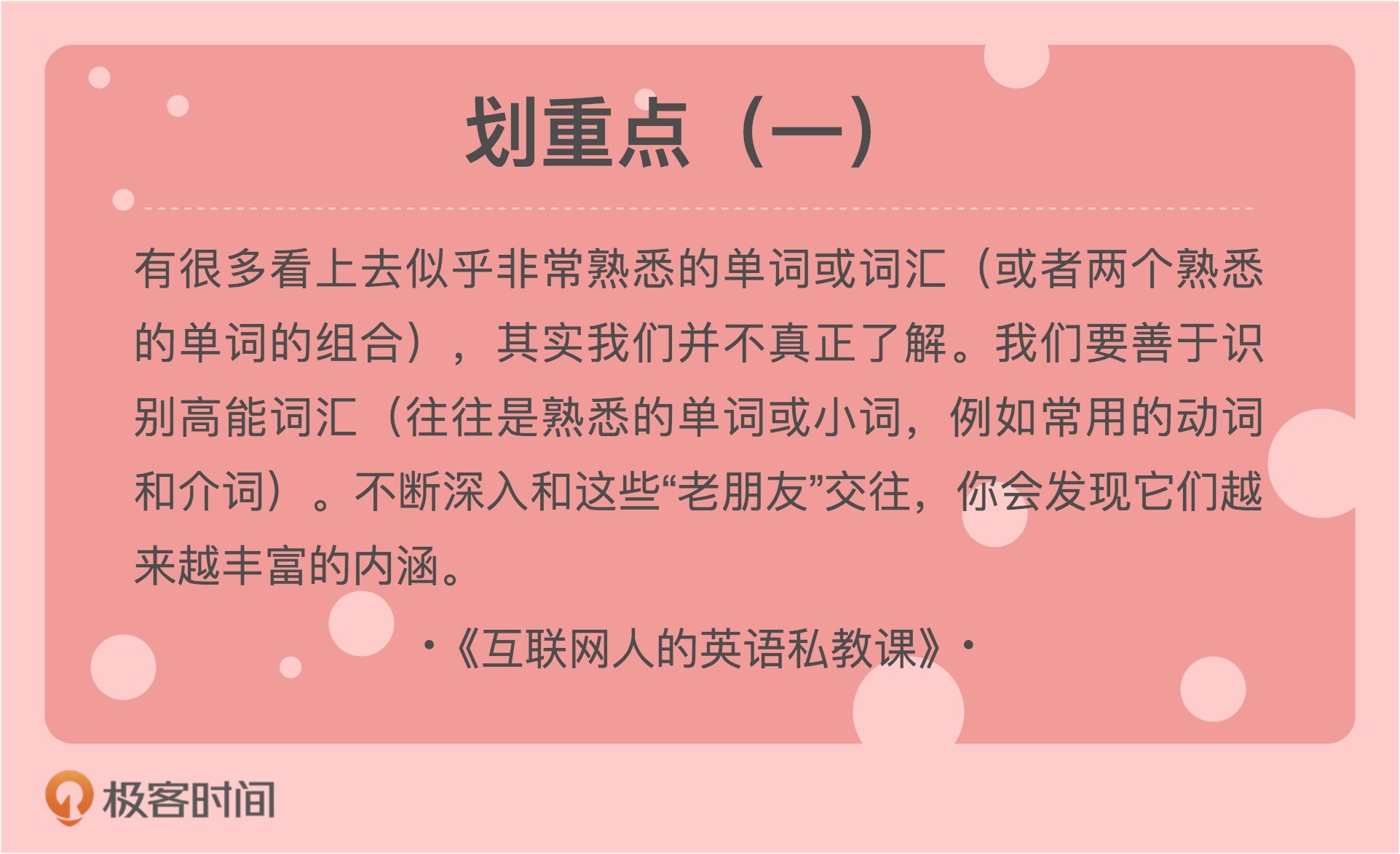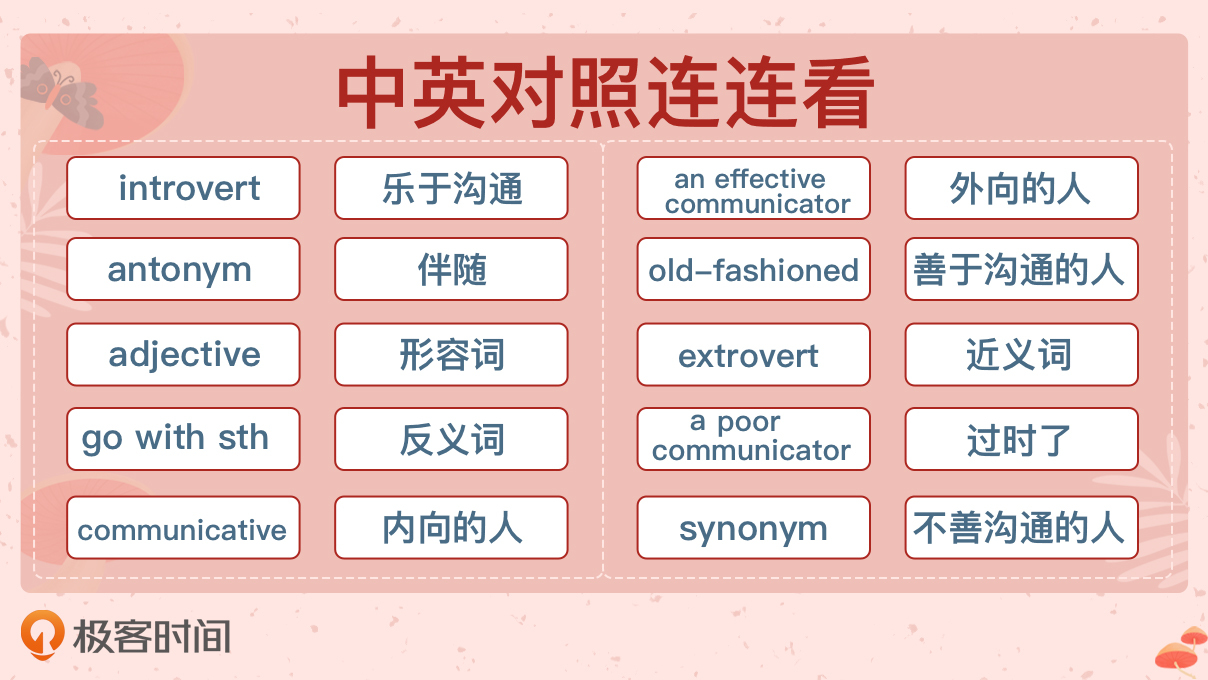 ### 2.introvert vs. extrovert
这是一对反义词(antonym),指“内向的人”和“外向的人”。在查词典的时候,无论查哪一个,一般词典都会提示你另外一个。我们不要放过这样举一反三的学习机会,先一起来看一下朗文词典的解释:
### 2.introvert vs. extrovert
这是一对反义词(antonym),指“内向的人”和“外向的人”。在查词典的时候,无论查哪一个,一般词典都会提示你另外一个。我们不要放过这样举一反三的学习机会,先一起来看一下朗文词典的解释:
introvert: someone who is quiet and shy, and does not enjoy being with other people
内向的人:安静、腼腆、不喜欢与人交往的人;
extrovert: someone who is active and confident, and who enjoys spending time with other people
外向的人:活泼、自信、喜欢与人交往的人。
 ### 3.communicator
在阅读理解上,这个词本身对于你来说应该没有什么困难,因为你肯定认识communicate这个动词,可以猜得出这个词是communicate的名词形式,表示“沟通的人”。
我们在学习词汇的时候,要慢慢养成一个好习惯,就是认识一个词之后,学会同时去了解这个词的大家庭。就像你以前认识communicate这个动词,成为了好朋友,今天阅读一篇文章看到communicator,和communicate这个动词长得很像,猜大概这是它的名词弟弟,然后也和他成为好朋友,然后你就习惯性地想要去了解他更多的家庭成员,例如形容词妹妹。
查阅朗文词典,你会发现,无论是查communicate还是communicator,单词下面都会有一个黄色的小框提示“Word family”,这个“单词家族”的标签后面会罗列所有相关的词汇,包括:
- 名词 (noun) communication communicator
- 形容词 (adjective) communicative ≠ uncommunicative
- 动词 (verb) communicate
对于不熟悉的家族成员,我们需要通过英文解释和例句去深入了解它们,熟悉其用法。例如,多读几个例句之后,我们会知道communicator本身是中性词,只是表示一个在说话交流的人,如果要说一个人“善于沟通”“有说服力”等,可以在前面加上形容词,说某人是个good/skilled/convincing/persuasive/compelling/effective communicator。同样道理,如果说某人“不善沟通”,可以说他是个poor communicator。你可以看下面这个例句。
例句:Many employees complain that their bosses are poor communicators and bad at giving clear instructions.
### 3.communicator
在阅读理解上,这个词本身对于你来说应该没有什么困难,因为你肯定认识communicate这个动词,可以猜得出这个词是communicate的名词形式,表示“沟通的人”。
我们在学习词汇的时候,要慢慢养成一个好习惯,就是认识一个词之后,学会同时去了解这个词的大家庭。就像你以前认识communicate这个动词,成为了好朋友,今天阅读一篇文章看到communicator,和communicate这个动词长得很像,猜大概这是它的名词弟弟,然后也和他成为好朋友,然后你就习惯性地想要去了解他更多的家庭成员,例如形容词妹妹。
查阅朗文词典,你会发现,无论是查communicate还是communicator,单词下面都会有一个黄色的小框提示“Word family”,这个“单词家族”的标签后面会罗列所有相关的词汇,包括:
- 名词 (noun) communication communicator
- 形容词 (adjective) communicative ≠ uncommunicative
- 动词 (verb) communicate
对于不熟悉的家族成员,我们需要通过英文解释和例句去深入了解它们,熟悉其用法。例如,多读几个例句之后,我们会知道communicator本身是中性词,只是表示一个在说话交流的人,如果要说一个人“善于沟通”“有说服力”等,可以在前面加上形容词,说某人是个good/skilled/convincing/persuasive/compelling/effective communicator。同样道理,如果说某人“不善沟通”,可以说他是个poor communicator。你可以看下面这个例句。
例句:Many employees complain that their bosses are poor communicators and bad at giving clear instructions. ### 4.Susan Cain
一篇文章读下来,我们经常会碰到一些专有名词,比如人名、地名、公司名、某个朝代或史前地质年代。我曾经的坏习惯是对这些专有名词视而不见,反正我知道那是某个人、某条河、某个公司或者某个年代就行了,至于里面的张三李四、什么具体的山脉、那家公司干什么的或者那个朝代大概是什么时间概念,往往没有兴趣去深入了解。因为我总觉得,即使不了解这些专有名词,也不会影响对这段话基本意思的理解。
后来,慢慢地我发现,这其实是个坏习惯,以至于让我错过了很多非常好的学习机会。一个人在自己的文章或书籍中引用其他人的话或者事迹,往往证明这个人是非常重要的,非常值得我们花时间去搜索一下。
通过搜索,我们会知道苏珊·凯恩(Susan Cain)毕业于普林斯顿大学和哈佛大学的法学院,曾经是一位出色的律师,后来成为一名社会活动家,创立了一个叫做“安静的革命”([Quiet Revolution](https://www.quietrev.com/))的社会运动,她的著作《安静的力量:内向孩子的秘密力量》(Quiet Power: The Secret Strengths of Introverted Kids)和《安静:内向者在一个滔滔不绝的世界中的力量》(Quiet: The Power of Introverts in A World That Can’t Stop Talking)畅销不衰。这些信息都足以让我们更加深入地去了解一个人和她的思想。
我觉得产生这个坏习惯的根本原因是心态问题,归根到底是学习不求甚解、懂个大概就好的毛病,最后一篇文章或者一本书看完,再和别人谈起,只能似是而非地讲述一个大概,很多干货却基本忘记了。因此,在之后的阅读过程中,我们可以刻意去查一查这些专有名词,说不定会有不一样的收获。
### 4.Susan Cain
一篇文章读下来,我们经常会碰到一些专有名词,比如人名、地名、公司名、某个朝代或史前地质年代。我曾经的坏习惯是对这些专有名词视而不见,反正我知道那是某个人、某条河、某个公司或者某个年代就行了,至于里面的张三李四、什么具体的山脉、那家公司干什么的或者那个朝代大概是什么时间概念,往往没有兴趣去深入了解。因为我总觉得,即使不了解这些专有名词,也不会影响对这段话基本意思的理解。
后来,慢慢地我发现,这其实是个坏习惯,以至于让我错过了很多非常好的学习机会。一个人在自己的文章或书籍中引用其他人的话或者事迹,往往证明这个人是非常重要的,非常值得我们花时间去搜索一下。
通过搜索,我们会知道苏珊·凯恩(Susan Cain)毕业于普林斯顿大学和哈佛大学的法学院,曾经是一位出色的律师,后来成为一名社会活动家,创立了一个叫做“安静的革命”([Quiet Revolution](https://www.quietrev.com/))的社会运动,她的著作《安静的力量:内向孩子的秘密力量》(Quiet Power: The Secret Strengths of Introverted Kids)和《安静:内向者在一个滔滔不绝的世界中的力量》(Quiet: The Power of Introverts in A World That Can’t Stop Talking)畅销不衰。这些信息都足以让我们更加深入地去了解一个人和她的思想。
我觉得产生这个坏习惯的根本原因是心态问题,归根到底是学习不求甚解、懂个大概就好的毛病,最后一篇文章或者一本书看完,再和别人谈起,只能似是而非地讲述一个大概,很多干货却基本忘记了。因此,在之后的阅读过程中,我们可以刻意去查一查这些专有名词,说不定会有不一样的收获。
 ## 小结
好了,短短两段话,看似普普通通,阅读的时候或许一眼就扫过去了,其实里面还是藏着很多语言精华的。今天我们只讲了四个词汇,下节课我们再讲五个词汇。
正如我一开始讲的,词汇本身并不是主要目的,我希望通过学习这些词汇,帮你梳理一下英语词汇学习的要点。首先,英语词汇学习的唯一有效途径只有一个,就是阅读,reading、reading、reading。重要的事情说三遍。其次,英语词汇学习要日积月累,并且不断复习和应用,repeat、repeat、repeat。
最后,像之前一样,我给你准备了一个简单的连线小游戏,你可以在大脑中把左右两列对应的项连起来。你可以通过这个过程,回顾这些词的使用场景。
## 小结
好了,短短两段话,看似普普通通,阅读的时候或许一眼就扫过去了,其实里面还是藏着很多语言精华的。今天我们只讲了四个词汇,下节课我们再讲五个词汇。
正如我一开始讲的,词汇本身并不是主要目的,我希望通过学习这些词汇,帮你梳理一下英语词汇学习的要点。首先,英语词汇学习的唯一有效途径只有一个,就是阅读,reading、reading、reading。重要的事情说三遍。其次,英语词汇学习要日积月累,并且不断复习和应用,repeat、repeat、repeat。
最后,像之前一样,我给你准备了一个简单的连线小游戏,你可以在大脑中把左右两列对应的项连起来。你可以通过这个过程,回顾这些词的使用场景。
 ## 课后作业
1.这是苏珊·凯恩2012年在TED上的演讲“[内向性格的力量](https://www.ted.com/talks/susan_cain_the_power_of_introverts)”。这个视频已经被观看了近2600万次,成为有史以来最受欢迎的演讲之一。ted.com上几乎所有的演讲都配有多个语种的脚本(包括简体和繁体中文以及英语),是非常好的练习听力和阅读的学习材料。
2.利用我今天讲过的概念和方法,自学本文第二部分的词汇。我同样对前两段的重点词汇做了加粗。你可以用我们今日的方法来学一学下面这些词汇,然后我们一起在留言区讨论词汇学习的心得体会。
>
**Myth: Engineers Don’t Make “Natural” Leaders**
>
This myth follows an even more **generalized** myth that leaders are **born**, **not made**. Research on leadership development suggests that this simply is not true, and in fact 70 percent of leadership ability is the result of lessons learned through life experiences.
>
A foundational concept of leadership development is often referred to as “leadership **readiness**.” It is a belief inside someone that they are truly ready, willing, and able to become a leader. People who believe this about themselves can develop much more quickly, and this isn’t surprising. This idea is very much in-line with other research done by **Carol Dweck** about having **a “growth” mindset versus a “fixed” mindset** so that we believe we can continue to develop and change throughout our lives.
>
**Assess Your Strengths**
>
One of the ways to discover that we are capable of leadership is to identify the strengths that we have and find ways to utilize them. There are a lot of free and paid assessments out there, such as CliftonStrengths by Gallup to help you do this, but a very simple approach is to ask people who know you well.
>
Go ahead – ask the ten people in your life who know you better than anyone else what they think your top three personal strengths are. Likely, you will agree with a lot of what they say. They may also share with you things that you don’t currently believe about yourself, but because others are suggesting it, you may start to believe a little bit more.
>
**Crushing Limiting Belief Activity**: This may seem a bit weird, but stay with me. Take about five minutes and jot down a quick list of what you consider to be your weaknesses. Then grab a piece of paper or note card and write down each of those “weaknesses” that you identified that is actually a limiting belief. Take that paper with the list of limiting beliefs and rip it up. Throw it into the air. Make a mess. Show those beliefs you don’t accept them. For example, my weakness might be that I tend to suppress my emotions which can lead to less connection in my relationships. A limiting belief I used to accept was that I was not a good writer. You may or may not agree with that, but at least I am pushing through and practicing my skills! I would write that on a note card and rip it up. I promise, it feels good.
>
**Look Inside**
>
The fact of the matter is that people rarely make huge changes in their lives, but people do change. It happens when we can increase self-awareness and have “ah-ha” moments or epiphanies that help us see ourselves and our situations in a new light. That’s really how we change our mindsets, which then drives our behaviors in new ways.
>
I’ve seen people who were so bent on blaming others that they became so toxic and were about to be fired. Yet they were able to create just enough space to realize they were part of the problem and began focusing on what they could change, rather than blaming everyone else. It’s transformational.
>
**Mindset Adjustment Activity**: Identify the largest work challenge you are facing right now. Write down what you think the root cause of the problem is. Then, write down 2-3 things you can do personally to make things better (this is not about you taking action to fix other people – focus on you). Then, stay focused on your own ability to help the cause rather than what others are/aren’t doing.
如果在学习中有什么问题,你可以在留言区提问,同时欢迎你把学习心得分享出来,我们一起每天进步一点。
## 课后作业
1.这是苏珊·凯恩2012年在TED上的演讲“[内向性格的力量](https://www.ted.com/talks/susan_cain_the_power_of_introverts)”。这个视频已经被观看了近2600万次,成为有史以来最受欢迎的演讲之一。ted.com上几乎所有的演讲都配有多个语种的脚本(包括简体和繁体中文以及英语),是非常好的练习听力和阅读的学习材料。
2.利用我今天讲过的概念和方法,自学本文第二部分的词汇。我同样对前两段的重点词汇做了加粗。你可以用我们今日的方法来学一学下面这些词汇,然后我们一起在留言区讨论词汇学习的心得体会。
>
**Myth: Engineers Don’t Make “Natural” Leaders**
>
This myth follows an even more **generalized** myth that leaders are **born**, **not made**. Research on leadership development suggests that this simply is not true, and in fact 70 percent of leadership ability is the result of lessons learned through life experiences.
>
A foundational concept of leadership development is often referred to as “leadership **readiness**.” It is a belief inside someone that they are truly ready, willing, and able to become a leader. People who believe this about themselves can develop much more quickly, and this isn’t surprising. This idea is very much in-line with other research done by **Carol Dweck** about having **a “growth” mindset versus a “fixed” mindset** so that we believe we can continue to develop and change throughout our lives.
>
**Assess Your Strengths**
>
One of the ways to discover that we are capable of leadership is to identify the strengths that we have and find ways to utilize them. There are a lot of free and paid assessments out there, such as CliftonStrengths by Gallup to help you do this, but a very simple approach is to ask people who know you well.
>
Go ahead – ask the ten people in your life who know you better than anyone else what they think your top three personal strengths are. Likely, you will agree with a lot of what they say. They may also share with you things that you don’t currently believe about yourself, but because others are suggesting it, you may start to believe a little bit more.
>
**Crushing Limiting Belief Activity**: This may seem a bit weird, but stay with me. Take about five minutes and jot down a quick list of what you consider to be your weaknesses. Then grab a piece of paper or note card and write down each of those “weaknesses” that you identified that is actually a limiting belief. Take that paper with the list of limiting beliefs and rip it up. Throw it into the air. Make a mess. Show those beliefs you don’t accept them. For example, my weakness might be that I tend to suppress my emotions which can lead to less connection in my relationships. A limiting belief I used to accept was that I was not a good writer. You may or may not agree with that, but at least I am pushing through and practicing my skills! I would write that on a note card and rip it up. I promise, it feels good.
>
**Look Inside**
>
The fact of the matter is that people rarely make huge changes in their lives, but people do change. It happens when we can increase self-awareness and have “ah-ha” moments or epiphanies that help us see ourselves and our situations in a new light. That’s really how we change our mindsets, which then drives our behaviors in new ways.
>
I’ve seen people who were so bent on blaming others that they became so toxic and were about to be fired. Yet they were able to create just enough space to realize they were part of the problem and began focusing on what they could change, rather than blaming everyone else. It’s transformational.
>
**Mindset Adjustment Activity**: Identify the largest work challenge you are facing right now. Write down what you think the root cause of the problem is. Then, write down 2-3 things you can do personally to make things better (this is not about you taking action to fix other people – focus on you). Then, stay focused on your own ability to help the cause rather than what others are/aren’t doing.
如果在学习中有什么问题,你可以在留言区提问,同时欢迎你把学习心得分享出来,我们一起每天进步一点。